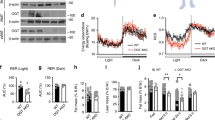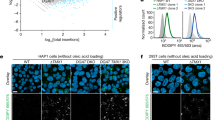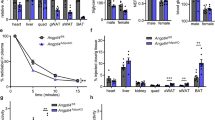Abstract
Triglycerides (or triacylglycerols) represent the major form of stored energy in eukaryotes. Triglyceride synthesis has been assumed to occur primarily through acyl CoA:diacylglycerol transferase (Dgat), a microsomal enzyme that catalyses the final and only committed step in the glycerol phosphate pathway1,2,3. Therefore, Dgat has been considered necessary for adipose tissue formation and essential for survival. Here we show that Dgat-deficient (Dgat−/−) mice are viable and can still synthesize triglycerides. Moreover, these mice are lean and resistant to diet-induced obesity. The obesity resistance involves increased energy expenditure and increased activity. Dgat deficiency also alters triglyceride metabolism in other tissues, including the mammary gland, where lactation is defective in Dgat−/− females. Our findings indicate that multiple mechanisms exist for triglyceride synthesis and suggest that the selective inhibition of Dgat-mediated triglyceride synthesis may be useful for treating obesity.
This is a preview of subscription content, access via your institution
Access options
Subscribe to this journal
Receive 12 print issues and online access
$209.00 per year
only $17.42 per issue
Buy this article
- Purchase on Springer Link
- Instant access to full article PDF
Prices may be subject to local taxes which are calculated during checkout




Similar content being viewed by others
References
Brindley, D.N. in Biochemistry of Lipids, Lipoproteins and Membranes (eds Vance, D.E. & Vance, J.E.) 171–203 (Elsevier, Amsterdam, 1991).
Bell, R.M. & Coleman, R.A. Enzymes of glycerolipid synthesis in eukaryotes. Annu. Rev. Biochem. 49, 459 –487 (1980).
Lehner, R. & Kuksis, A. Biosynthesis of triacylglycerols . Prog. Lipid Res. 35, 169– 201 (1996).
Cases, S. et al. Identification of a gene encoding an acyl CoA:diacylglycerol acyltransferase, a key enzyme in triacylglycerol synthesis. Proc. Natl Acad. Sci. USA 95, 13018–13023 (1998).
Jensen, D.R. et al. Prevention of diet-induced obesity in transgenic mice overexpressing skeletal muscle lipoprotein lipase. Am. J. Physiol. 273, R683–R689 (1997).
Moitra, J. et al. Life without white fat: a transgenic mouse. Genes Dev. 12, 3168–3181 ( 1998).
Shimomura, I. et al. Insulin resistance and diabetes mellitus in transgenic mice expressing nuclear SREBP-1c in adipose tissue: model for congenital generalized lipodystrophy. Genes Dev. 12, 3182– 3194 (1998).
Kamohara, S., Burcelin, R., Halaas, J.L., Friedman, J.M. & Charron, M.J. Acute stimulation of glucose metabolism in mice by leptin treatment. Nature 389, 374–377 (1997).
Ogawa, Y. et al. Increased glucose metabolism and insulin sensitivity in transgenic skinny mice overexpressing leptin. Diabetes 48, 1822–1829 (1999).
Shimabukuro, M. et al. Direct antidiabetic effect of leptin through triglyceride depletion of tissues. Proc. Natl Acad. Sci. USA 94, 4637–4641 (1997).
Chen, G. et al. Disappearance of body fat in normal rats induced by adenovirus-mediated leptin gene therapy. Proc. Natl Acad. Sci. USA 93, 14795–14799 (1996).
Shimomura, I., Hammer, R.E., Ikemoto, S., Brown, M.S. & Goldstein, J.L. Leptin reverses insulin resistance and diabetes mellitus in mice with congenital lipodystrophy. Nature 401, 73–76 ( 1999).
Meiner, V.L. et al. Disruption of the acyl-CoA:cholesterol acyltransferase gene in mice: evidence suggesting multiple cholesterol esterification enzymes in mammals. Proc. Natl Acad. Sci. USA 93, 14041 –14046 (1996).
Lehner, R. & Kuksis, A. Triacylglycerol synthesis by an sn-1,2(2,3)-diacylglycerol transacylase from rat intestinal microsomes . J. Biol. Chem. 268, 8781– 8786 (1993).
Hanks, M., Wurst, W., Anson-Cartwright, L., Auerbach, A.B. & Joyner, A.L. Rescue of the En-1 mutant phenotype by replacement of En-1 with En-2. Science 269, 679–682 ( 1995).
Erickson, S.K., Shrewsbury, M.A., Brooks, C. & Meyer, D.J. Rat liver acyl-coenzyme A:cholesterol acyltransferase: its regulation in vivo and some of its properties in vitro. J. Lipid Res. 21, 930–941 (1980).
Bligh, E.G. & Dyer, W.J. A rapid method of total lipid extraction and purification. Can. J. Biochem. Physiol. 37, 911–917 (1959).
Mahley, R.W. et al. Turkish heart study: lipids, lipoproteins, and apolipoproteins . J. Lipid Res. 36, 839– 859 (1995).
de V. Weir, J.B. New methods for calculating metabolic rate with special reference to protein metabolism. J. Physiol. 109, 1– 9 (1949).
Acknowledgements
We thank H. Myers for assistance with embryonic stem cell culture; T. Yu for blastocyst injections; S. Erickson for advice concerning Dgat assays; D. Newland for assistance with histology; T. Marcell for assistance with insulin measurements; J. McGuire for assistance with gas chromatography; S. Ammon for assistance with calorimetry measurements; G. Su for assistance with activity measurements; J. Carroll and S. Gonzales for graphics; S. Ordway and G. Howard for editorial assistance; B. Taylor for manuscript preparation; and B. Conklin, R. Farese Sr, J. Herz and K. Weisgraber for helpful comments on the manuscript. This work was supported by the National Institutes of Health, the Sandler Family Supporting Foundation, a Howard Hughes Medical Institute grant for transgenic mice and The J. David Gladstone Institutes.
Author information
Authors and Affiliations
Corresponding author
Rights and permissions
About this article
Cite this article
Smith, S., Cases, S., Jensen, D. et al. Obesity resistance and multiple mechanisms of triglyceride synthesis in mice lacking Dgat. Nat Genet 25, 87–90 (2000). https://doi.org/10.1038/75651
Received:
Accepted:
Issue Date:
DOI: https://doi.org/10.1038/75651
This article is cited by
-
Beyond IBD: the genetics of other early-onset diarrhoeal disorders
Human Genetics (2023)
-
Spatial mapping of mitochondrial networks and bioenergetics in lung cancer
Nature (2023)
-
Genetic diversity of DGAT1 gene linked to milk production in cattle populations of Ethiopia
BMC Genomic Data (2022)
-
Therapeutic RNA-silencing oligonucleotides in metabolic diseases
Nature Reviews Drug Discovery (2022)
-
ATGL is a biosynthetic enzyme for fatty acid esters of hydroxy fatty acids
Nature (2022)



